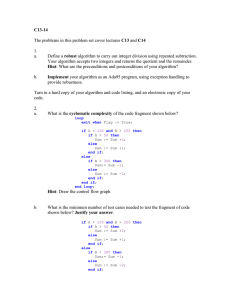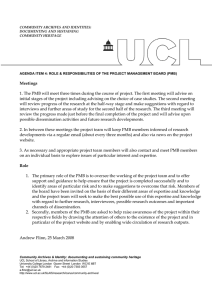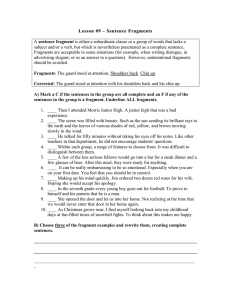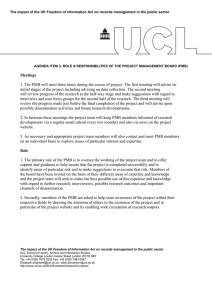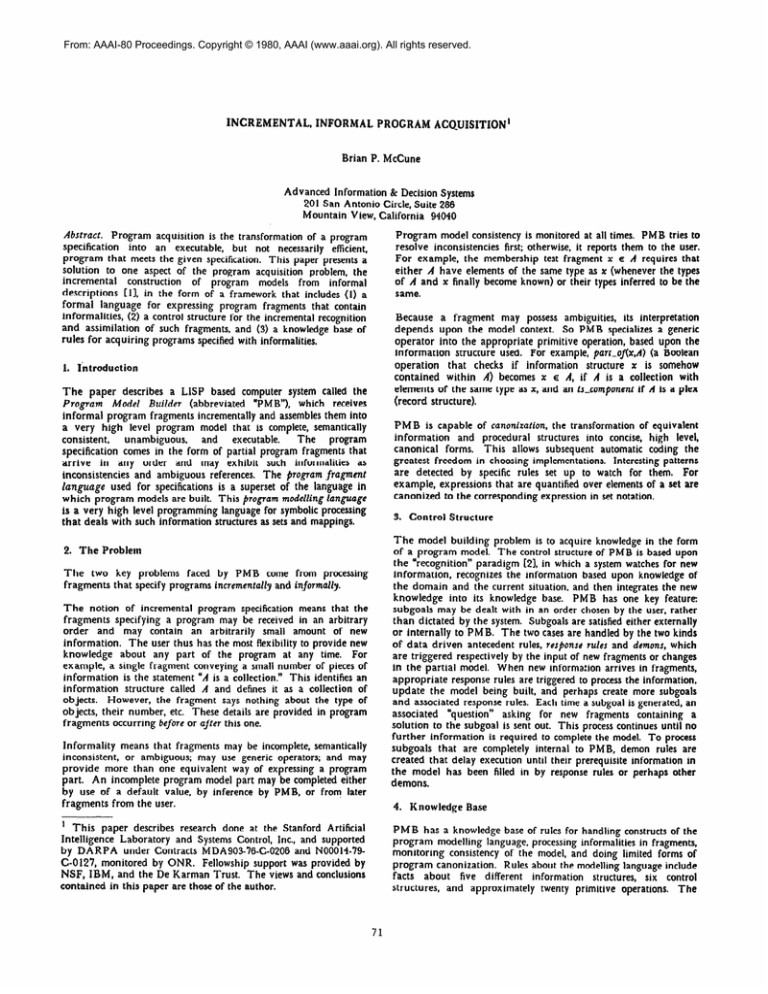
From: AAAI-80 Proceedings. Copyright © 1980, AAAI (www.aaai.org). All rights reserved.
INCREMENTAL, INFORMAL PROGRAM ACQUISITION’
Brian P. McCune
Advanced Information & Decision Systems
201 San Antonio Circle, Suite 286
Mountain View, California 94040
Program model consistency is monitored at all times. PMB tries to
resolve inconsistencies first; otherwise, it reports them to the user.
For example, the membership test fragment x E A requires that
either A have elements of the same type as x (whenever the types
of R and x finally become known) or their types inferred to be the
same.
AbJrract. Program acquisition is the transformation of a program
specification into an executable, but not necessarily efficient,
program
that meets the given specification. This paper presents a
solution to one aspect of the program acquisition problem, the
incremental
construction of program models from informal
descriptions [II, in the form of a framework that includes (1) a
formal language for expressing program fragments that contain
informalities, (2) a control structure for the incremental recognition
and assimilation of such fragments, and (3) a knowledge base of
rules for acquiring programs specified with informalities.
Because a fragment may possess ambiguities, its interpretation
depends upon the model context. So PMB specializes a generic
operator into the appropriate primitive operation, based upon the
information structure used. For example, part-oflx,A) (a Boolean
operation that checks if information structure x is somehow
contained within A) becomes x E R, if A is a collection with
if A is a plex
elements of the same type as X, and an k.componenr
(record structure).
1. Introduction
The paper describes a LISP based computer system called the
Program
Model
Builder
(abbreviated “PMB”), which receives
informal program fragments incrementally and assemblesthem into
a very high level program model that is complete, semantically
unambiguous,
and
executable.
The
program
consistent,
specification comes in the form of partial program fragments that
arrive in any order and may exhibit such informalities as
inconsistencies and ambiguous references. The program fragment
language
used for specifications is a superset of the language in
which program models are built. This program modelling language
is a very high level programming language for symbolic processing
that deals with such information structures as sets and mappings.
PMB is capable of canonization, the transformation of equivalent
information
and procedural structures into concise, high level,
canonical forms. This allows subsequent automatic coding the
greatest freedom in choosing implementations. Interesting patterns
are detected by specific rules set up to watch for them. For
example, expressions that are quantified over elements of a set are
canonized to the corresponding expression in set notation.
3. Control Structure
The model building problem is to acquire knowledge in the form
of a program model. The control structure of PMB is based upon
the “recognition” paradigm 121,in which a system watches for new
information, recognizes the information based upon knowledge of
the domain and the current situation, and then integrates the new
knowledge into its knowledge base. PMB has one key feature:
subgoals may be dealt with in an order chosen by the user, rather
than dictated by the system. Subgoals are satisfied either externally
or internally to PMB. The two casesare handled by the two kinds
of data driven antecedent rules, response rules and demons, which
are triggered respectively by the input of new fragments or changes
in the partial model. When new information arrives in fragments,
appropriate response rules are triggered to processthe information,
update the model being built, and perhaps create more subgoals
and associated response rules. Each time a subgoal is generated, an
associated “question” asking for new fragments containing a
solution to the subgoal is sent out. This processcontinues until no
further information is required to complete the model. To process
subgoals that are completely internal to PMB, demon rules are
created that delay execution until their prerequisite information in
the model has been filled in by response rules or perhaps other
demons.
2. The Problem
The two key problems faced by PMB come from processing
fragments that specify programs incrementally and informally.
The notion of incremental program specification means that the
fragments specifying a program may be received in an arbitrary
order and may contain an arbitrarily small amount of new
information. The user thus has the most flexibility to provide new
knowledge about any part of the program at any time. For
example, a single fragment conveying a small number of pieces of
information is the statement “A is a collection.” This identifies an
information structure called A and defines it as a collection of
objects. However, the fragment says nothing about the type of
objects, their number, etc. These details are provided in program
fragments occurring before or after this one.
Informality means that fragments may be incomplete, semantically
inconsistent, or ambiguous; may use generic operators; and may
provide more than one equivalent way of expressing a program
part. An incomplete program model part may be completed either
by use of a default value, by inference by PMB, or frog later
fragments from the user.
4. Knowledge Base
’ This paper describes research done at the Stanford Artificial
Intelligence Laboratory and Systems Control, Inc., and supported
by DARPA under Contracts MDA903-76-C-0206 and NOOOl4-79
C-0127, monitored by ONR. Fellowship support was provided by
NSF, IBM, and the De Karman Trust. The views and conclusions
contained in this paper are those of the author.
PMB has a knowledge base of rules for handling constructsof the
program modelling language. processing informalities in fragments,
monitoring consistency of the model, and doing limited forms of
program canonization. Rules about the modelling language include
facts about five different information structures, six control
structures, and approximately twenty primitive operations. The
71
control structures are ones that are common to mose high level
languages. The modelling language’s real power comes from its
very high level operators for information structures such as sets,
lists, mappings, records, and alternatives of these.
algorithm-body:
begin
input-concept
classify-loop
end
Below are English paraphrases of three rules that exemplify the
major types of rules used in PMB. Rule I is a response rule for
processing a new loop. Rule 2 is a demon that checks that the
arguments of an i~-&~et
operation are consistent. Rule 3 is a
canonization demon that transforms a case into a test when
appropriate.
CA composite is a compound statement with an optional partial
ordering on the execution of its subparts. The response rule that
processes the composite creates the following two subgoals, along
with response rules to handle them (not shown).]
Processing
ALGORITHM-BOOY.TYPE = COMPOSITE
Creating
subgoal:
[II
A loop consists of an optional initialization, required body,
and required pairs of exit tests and exit blocks. Each exir test must
be a Boolean expression occurring within the body.
ALGORITHM-BOOY.SUBPARTS- 711
Creating
Done
[21 Require that the two arguments of an is-J&Jet operation both
return collections of the same prototypic element.
[Within
the same fragment the two subparts are
operational units with unique names, but of unknown
operational
unit can be any control structure, primitive
or procedure call. Two new templates are created and
are requested.1
[31 If the statement is a case, the case has two condition/action
pairs, and the first condition is the negation of the second
condition, then change the case into a test.
Both response rules and simple demons are procedural.
Compound
demons (i.e., those whose antecedents test more than one object in
the model) use declarative antecedent patterns that are expanded
automatically into procedural form by a rule “compiler”.
The model building excerpt below displays (1) growth of the
program model tree in a fashion that is generally top down, but
data driven, and (2) completion and monitoring of parts of the
model by demons. Note that this excerpt does justice neither to the
concept of arbitrary order 6f fragments nor the types of
programming knowledge in PMB.
[At this point, the model
of the composite.]
Current
The trace discusses three program fragments generated from an
English dialog. Each fragment is followed by a description of how
it was processed by PMB, a snapshot of the partial model at that
point, and a list of the outstanding demons. A detailed trace for
the first fragment shows PMB focusing on individual slots of a
fragment, creating model templates, and creating subgoals. The
other fragments emphasize the creation and triggering of demons.
demons
Current
active:
None
The fourth fragment defines the second step of the composite.
This fragment might have come from “The classificaeionstep is a
loop with a single exit condition.“]
Inputting
fragment:
classify-loop:
until exit (exit-condition)
repeat loop-body
finally exit:
endloop
???
None
[This fragment defines a loop that repeats “loop-body” (as yet
undefined) until a Boolean expression called “exit-condition” is
true. At such time, the loop is exited to the empty exit block, called
“exit”, which is associated with “exit-condition”. Since PMB
doesn’t know precisely where the test of aexit-condition” will be
located, it is shown separately from the main algorithm below. The
response rule that processes the loop needs to guarantee that
“exit-condition” is contained within the body of the loop. Since
[The second fragment describes the top level algoriehm as a control
having
type composite
and two steps called
structure
“Input-concept” and “classify-loop”. This fragment might have
arisen from a sentence from the user such as “The algorithm first
inputs the concept and then classifiesit.“]
Inputting
demons
[The third fragment, which defines “input-concept” to be an input
primitive operation, is omitted. Information structures from this
fragment are not shown in the models below.
model:
act ive:
model:
end
program classify;
Current
missing the definitions of the two parts
Input-concept: ???;
classify-loop: ???
[The excerpt starts after the first fragment has already caused the
partial program model shown below to be created. It only contains
the names of the model, CLASSIFY,
and the main algorithm,
“algorithm-body”. No demons exist.]
algorithm-body:
program
IS
program classify;
begin
Names preceding colons are unique template names that allow
fragments to refer to different parts of the model. Missing parts of
the partial model are denoted by “???“.Newly added or changed
lines are denoted by the character ‘I” at the right margin.
program
defined as
types. An
operation,
their types
Process
i ng ALGORI THM-BODY. SUBPARTS =
(INPUT-CONCEPT
CLASSIFY-LOOP)
Creating
template
INPUT-CONCEPT with value
I NPUT-CONCEPT. CLASS - OPERAT I ONAL-UNI T
Creating
subgoal:
INPUT-CONCEPT.TYPE
- 131
Creating
template
CLASSIFY-LOOP with value
CLASSIFY-LOOP.CLASS
= OPERATIONAL-UNIT
Creating
subgoal:
CLASSIFY-LOOP. TYPE = ???
Done processing
ALGORITHM-BOOY.SUBPARTS =
(INPUT-CONCEPT
CLASSIFY-LOOP)
5. Example of PMB in Operation
Current
subgoal:
ALGORITHM-BOOY.OROERINGS= 711
processing
ALGORITHM-BOOY,TYPE = COMPOSITE
fragment:
72
this can’t be determined until the location of “exit-condition” is
defined in a fragment, the response rule attaches Demon 1 to the
template for “exit-condition” to await this event. Similarly, Demon
2 is created to await the location of “exit-condition” and then put it
inside a test with an asserl-exit-connlilon
as its true branch. This
will cause the loop to be exited when the exit condition becomes
finally
exit:
endloop
end
Current
true.1
Current
program
model8
user, concept-prompt);
until exit
repeat
loop-body: ???
finally
exit:
endloop
PMB
was designed to operate as part of a more complete program
synthesis
system with two distinct phases: acquisition and
automatic coding. In such a system the program model would serve
as the interface between the two phases. Automatic coding is the
process of transforming a model into an efficient program without
human intervention. The model is acquired during the acquisition
phase; the model is coded only when it is complete and consistent.
I
I
I
end
???
Current
demons active:
Demon 1: awaiting control
“ex i t-cond i t i on”
Demon 2: awaiting control
“ex i t-cond i t i on”
PMB may work within a robust acquisition environment. In such
an environment, program fragments may come from many other
knowledge sources, such as those expert in traces and examples,
natural language, and specific programming domains. However,
the operation of PMB is not predicated on the existence of other
modules:
all fragments to PMB could be produced by a
straightforward
deterministic parser for a surface language such as
the one used to express fragments.
I
structure
containing
structure
containing
I
I
[The fifth fragment defines the body of the loop, thus triggering
the two demons set up previously. A possible source of this
fragment is ‘The loop first inputs a scene, tests whether the datum
that was input is really the signal to exit the loop, classifies the
scene, and then outpu&this classification to the user.“]
7. Conclusion
PMB has been used both as a module of the PSI program
synthesis system E31 and independently. Models built as part of
PSI have been acquired via natural language dialogs and
execution traces and have been automatically coded into LISP by
other PSI modules. PMB has successfully built a number of
moderately complex programs for symbolic computation.
fragment:
loop-body:
begin
loop-input;
exit-condition;
classification;
output-classification
end
The most important topics for future work in this area include (1)
extending
and revising the knowledge base, (2) providing an
efficient mechanism for testing alternate hypotheses and allowing
program modification, and (3) providing a general mechanism for
specifying where in the program model a program fragment is to
go. The last problem has resulted in a proposed program reference
[“Loop-body” is a composite with four named steps. PMB now
knows where “exit-condition” occurs and that it must return a
Boolean value. Demon I is awakened to find that “exit-condition”
is located inside the composite “loop-body”. Since this isn’t a loop,
Demon 1 continues up the tree of nested control constructs. It
immediately finds that the parent of “loop-body” is the desired
loop, and succeeds. Demon 2 is also awakened. Since it now
knows “exit-condition” and its parent, Demon 2 can create a new
The demon creates a test with
template
between them.
“exit-condition” as its predicate and an assert-exit-condition
that
will leave the loop as its true action.]
Current
program
I
have been
6. Role of PMB in a Program Synthesis System
concept c input(concept#otot~pe,
Inputting
None
[At the end of the excerpt, five of 32 fragments
processed.]
program classlf3r;
begirl
exit-condition:
demons act i ve:
language
8. References
P. McCune, Building Program Models Incrementally
Descriptions,
Ph.D. thesis, AIM-333, STAN-CS-79
772, AI Lab., CS Dept., Stanford Univ., Stanford, CA, Oct. 1979.
[I J
from
informal
Daniel G. Bobrow and Terry Winograd, “An Overview of
a Knowledge Representation Language”, Cognifive SCienCe,
Vol. 1, No. 1, Jan. 1977, pp. 3-46.
KRL,
[33 Cordell Green, Richard P. Gabriel, Elaine Kant, Beverly I.
Kedzierski, Brian P. McCune, Jorge V. Phillips, Steve T. Tappel,
and Stephen J. Westfold, “Results in Knowledge Based Program
program classify;
begin
user, concept-prompt);
until exit
repeat
begin
loop-input: ???;
if exit-condition: ???
then assert-exit-conditio(exit);
classification: ??!;
output-classification: ???
end
Brian
[2J
mode I :
concept t input(concept.$ototype,
I1 3.
Synthesis”,
Conference
1JCAI-79:
Proceedings of the Sixth International Joint
on Artijciai
Intelligence,
Vol. 1, CS Dept., Stanford
Univ., Stanford, CA, Aug. 1979, pp. 342-344.
I
I
73


